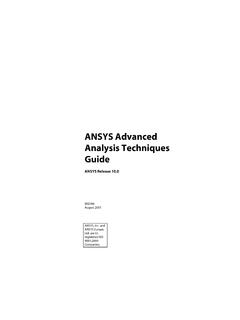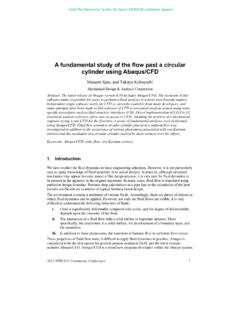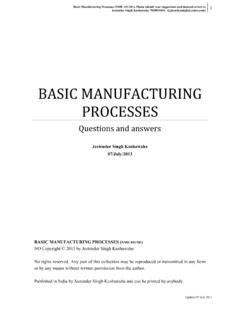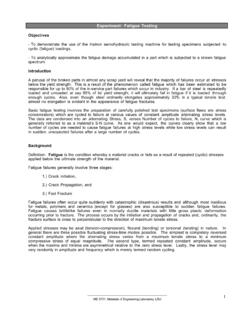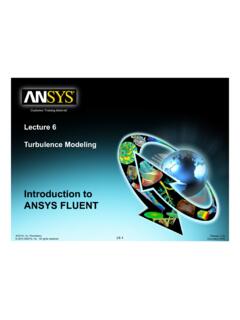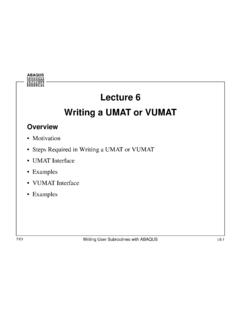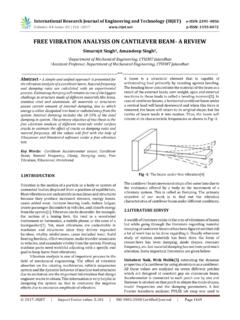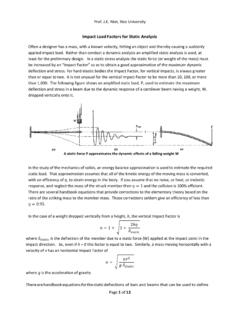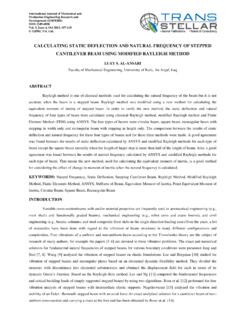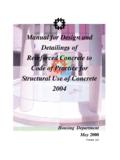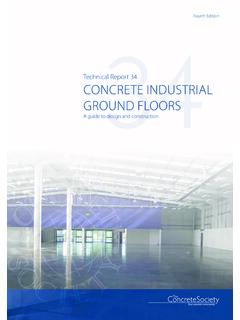Transcription of Vibrations of Cantilever Beams - iMechanica
1 Vibrations of Cantilever Beams : of 911/12/2006 4:17 PM Vibrations of Cantilever Beams :Deflection, Frequency, and Research Uses For: Dr. NegahbanEngrM 325H Scott WhitneyApril 23, 1999 IntroductionMeasurements of thin film properties are difficult when compared to bulk materials. One method for findingthe modulus of elasticity of a thin film is from frequency analysis of a Cantilever beam . A straight, horizontalcantilever beam under a vertical load will deform into a curve. When this force is removed, the beam willreturn to its original shape; however, its inertia will keep the beam in motion.
2 Thus, the beam will vibrate atits characteristic frequencies. If a thin film is sputtered onto the beam , the flexural rigidity will be of Cantilever Beams : of 911/12/2006 4:17 PMThis change causes the frequency of Vibrations to shift. If the frequency shift is measured, the film s elasticmodulus can be Cantilever beam SetupBeams studied in this paper are long, thin, Cantilever Beams . Figure 1, below, shows such a beam . One end ofthe beam is fixed, while the other end is free. The origin of the coordinate axis is at the fixed end, point A. Atypical beam , used in this study, is L = 30 mm long, w = 5 mm wide, and t = mm thick.
3 The beam materialmust be chosen so that its stiffness differs from the thin film s stiffness so that the frequency shift issignificant. This study involved zinc oxide films (about 5m thick), so a good substrate is 1: Typical Cantilever beam studiedDeflection of Cantilever BeamIf the free end of a Cantilever beam is subjected to a point load, P, the beam will deflect into a curve. SeeFigure 2 below. The larger the load, the greater the deflection, (x).Figure 2: Cantilever beam deflection under load at fixed endAssuming the beam undergoes small deflections, is in the linearly elastic region, and has a uniformcross-section, the following equations can be used (Gere, p.)
4 602).The curvature of the beam ,, is equal to the second derivative of the deflectionThe curvature can also be related to the bending moment, M, and the flexural rigidity, EI, Vibrations of Cantilever Beams : of 911/12/2006 4:17 PMwhere E is the elastic modulus of the beam and I is the moment of inertia. The bending moment in a beamcan be related to the shear force, V, and the lateral load, q, on the beam . Thus, (1a,b,c)For the load shown in Figure 2, the distributed load, shear force, and bending moment are:Thus, the solution to Equation (1a) is (2a)At the free end of the beam , the displacement is: (2b) Vibrations of Beams -Determination of EquationsWhen the force, P, is removed from a displaced beam , the beam will return to its original shape.
5 However,inertia of the beam will cause the beam to vibrate around that initial location. Assuming the elastic modulus,inertia, and cross sectional area (A) are constant along the beam length, the equation for that vibration is(Volterra, p. 310) (3)where is the linear mass density of the beam . Equation (3) is best solved by separation of variables(Atkins, p. A29). Assume that the displacement can be separated into two parts, one depends on position andanother on time.(x,t) = X(x)f(t) (4)where X is independent of time, and f is independent of position.
6 Then equation (3) becomes Dividing equation (3) byX(x)f(t): Vibrations of Cantilever Beams : of 911/12/2006 4:17 PM (5)Since the left side of equation (5) does not change as t varies, the right side must be a constant. Similarlysince the right half of equation (5) does not change as x varies, the left half must be a constant. Because eachside is constant, equation (4) is valid and the method of separation of variables may be used. Let this constantbe denoted. It can be shown that is a real quantity, and that are natural frequencies of the (5) can now be written as two differential equations (Volterra, p.)
7 311), (6a,b)where (6c)In order to solve equation (6a), the following boundary conditions for a Cantilever beam are neededThese boundary conditions come from the supports of a Cantilever beam . The fixed end must have zerodisplacement and zero slope due to the clamp. The free end cannot have a bending moment or a general solution to equation (6a) is a linear combination of trigonometric equations (Volterra, ) (7)Using the first boundary condition, C1 may be found => Taking the first derivative of equation (7) and using the second boundary condition, C3 may be found => The higher derivatives of equation (7), and remaining boundary conditions giveVibrations of Cantilever Beams : of 911/12/2006 4.
8 17 PM (8a) (8b)Equations (8a) and (8b) can be combined to give (9)Thus for a Cantilever beam , equation (7) reduces to (10)According to Volterra, p. 312, the constants Cn are arbitrary. However, in order for the dynamic solution forthe displacement to be equal to the static solution (at time t=0), C2 must be equal to . With this value forC2, Xn(0)=0 and Xn(L)= equation (9) into either (8a) or (8b) will lead to the frequency equation for a Cantilever beam , (11)The frequency equation can be solved for the constants, knL; the first six are shown below in Figure 3 (note,kn=0 is ignored since it implies that the bar is at rest because=0).
9 These constants along with equation (6c)can be used to find the natural frequencies of a Cantilever 3: Constants for a Cantilever beam Vibrations . Note, since cosh(x) is large when x is large, knLneeds to be found with high each frequency, there exists a characteristic vibration (Volterra, p. 319) (12)where An depends on the initial position at time t=0, and Bn depends on the initial velocity. In this study, thebeam starts its vibration when displaced and at rest. Thus Bn=0 and (13)The initial displacement,(x,0), was found above, equation (2a).
10 Equation (13) can be solved analytically byVibrations of Cantilever Beams : of 911/12/2006 4:17 PMa computer math program,-Examples of Vibration ModesTypical values of An and frequency (for Beams used in this study) are shown in Figure 3, above. Notice thatonly the first few modes of vibration have significantly large values for the constant An. Thus, the higher order vibration modes can be ignored. To get the total displacement of the Cantilever beam , simply add all thedisplacements found in equation (12) for each mode. Below, Figure 4 shows the displacement caused by eachmode at t=0; also included is the total initial displacement of the beam .
